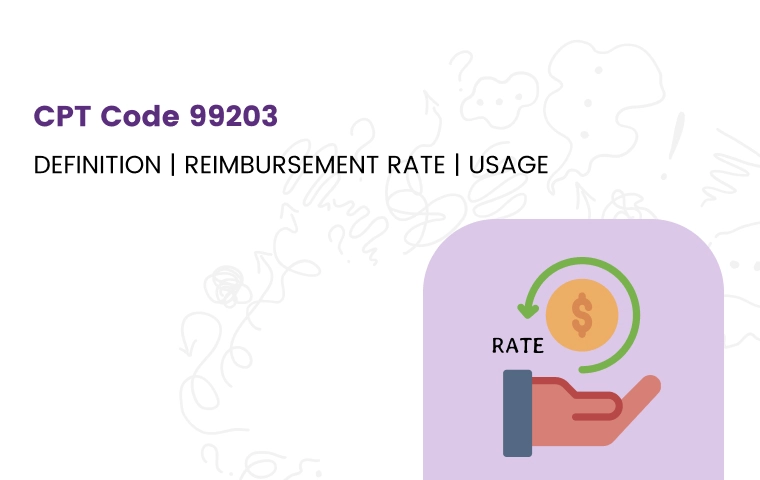With so many cpt codes, picking the perfect one for new patient visits can leave even seasoned healthcare providers feeling lost. This blog post cuts through the confusion and focuses on CPT code 99203, your key to accurate billing for new patient encounters. We'll break down the code's components and explore its proper use.
Whether you're a healthcare provider looking to refine your billing practices or just someone curious about the process, we've got you covered.
What is CPT Code 99203?
The description of CPT code 99203 states that it is an evaluation and management service provided to a new patient in an outpatient setting. It's the code used for an initial visit with a new patient where the doctor gathers comprehensive information, performs a thorough exam, and makes decisions about the patient's care plan. Still, the complexity of those decisions is considered to be on the lower end.
Key Components of CPT Code 99203
When using CPT code 99203, the following elements must be included in the patient encounter:
History: A detailed history must be taken. This includes the patient's chief complaint, history of present illness, review of systems, and past medical, family, and social history.
Examination: A detailed physical examination is required. This examination should cover multiple organ systems or a detailed examination of a single organ system.
Medical Decision Making (MDM): The medical decision-making involved must be of moderate complexity. This considers the number and complexity of problems addressed, the amount and complexity of data to be reviewed, and the risk of complications, morbidity, or mortality.
Remember: Many clinics often mistakenly use CPT code 99203 when they should be using CPT code 99213 for follow-up visits. If your clinic has seen the patient within the last three years, the patient is not considered a "new consult" but rather a follow-up. It’s crucial to distinguish between new and established patients to ensure accurate billing and avoid potential reimbursement issues.
99203 Time Requirement
The typical time associated with CPT code 99203 is approximately 30-44 minutes spent face-to-face with the patient and/or family. This time requirement is essential for ensuring that the visit is billed correctly under this code.
99203 vs 99204
CPT code 99204 signifies an established patient office visit with high complexity. Compared to 99203, this code represents a more intricate encounter. It involves an even more detailed history, a comprehensive examination, and medical decision-making of a high complexity level. The encounter for 99204 typically ranges from 45-59 minutes.
|
Feature |
CPT Code 99203 |
CPT Code 99204 |
|
Patient Status |
New Patient |
New Patient |
|
History Detail |
Detailed |
Even More Detailed |
|
Examination |
Comprehensive |
Comprehensive |
|
Medical Decision-Making |
Moderate |
High Complexity |
|
Encounter Time (approx.) |
30-44 minutes |
45-59 minutes |
99203 Reimbursement for 2024
For the year 2024, the reimbursement rate for CPT code 99203 varies depending on the payer and geographic location. Generally, Medicare reimbursement for CPT code 99203 is set at approximately $111.51.
This rate reflects a standard evaluation and management (E/M) visit for a new patient, involving a medically appropriate history and/or examination and low complexity in medical decision making.
Reimbursement rates for CPT code 99203 can vary by region, with some areas receiving slightly higher or lower rates depending on local Medicare administrative contractor policies and other insurance providers
Using Modifier 25 with CPT Code 99203
Modifier 25 can be applied with CPT code 99203 when specific conditions are met. Modifier 25 is used to indicate that a significant, separately identifiable evaluation and management (E/M) service was performed by the same physician or other qualified healthcare professional on the same day as another procedure or service.
When to Use Modifier 25 with CPT Code 99203
Modifier 25 should be appended to CPT code 99203 in the following scenarios:
-
Significant, Separately Identifiable E/M Service:
-
The E/M service provided must be distinct and significant enough to warrant additional reporting. This means that the E/M service should not be part of the usual preoperative or postoperative care associated with the procedure.
-
-
Same Day as Another Procedure:
-
Modifier 25 is used when the E/M service is performed on the same day as another procedure or service. For example, if a new patient comes in for an evaluation (coded as 99203) and, during the same visit, requires a minor surgical procedure (e.g., removal of a lesion), Modifier 25 would be appended to 99203 to indicate that the E/M service was separately identifiable from the procedure.
-
-
Documentation Requirements:
-
Proper documentation is crucial. The medical records should clearly distinguish the E/M service from the procedure. This includes detailing the patient's history, the examination performed, and the medical decision-making process that justify the E/M service as separate and significant.
-
Example Scenario
A patient presents with a new skin lesion. During the visit, the provider performs a detailed history and physical examination and determines that the lesion should be biopsied. The provider then performs the biopsy during the same visit. In this case:
-
CPT code 99203 would be used for the E/M service.
-
The biopsy procedure would be coded separately.
-
Modifier 25 would be appended to 99203 to indicate that the E/M service was significant and separately identifiable from the biopsy procedure.
By using Modifier 25 appropriately, healthcare providers can ensure accurate billing and proper reimbursement for the services provided during a single patient visit.
Final Words
Understanding and correctly using CPT code 99203 is essential for accurate billing and optimal reimbursement for new patient visits. This code covers comprehensive evaluations involving detailed history and examination with low complexity medical decision-making, typically lasting 30-44 minutes.
Knowing when to use 99203 versus 99204 can make a significant difference, as 99204 involves more complexity and a longer time commitment. By adhering to these guidelines, healthcare providers can enhance their billing accuracy, avoid errors, and secure fair compensation for their services.
ABOUT AUTHOR

John Wick
As a blog writer with years of experience in the healthcare industry, I have got what it takes to write well-researched content that adds value for the audience. I am a curious individual by nature, driven by passion and I translate that into my writings. I aspire to be among the leading content writers in the world.
